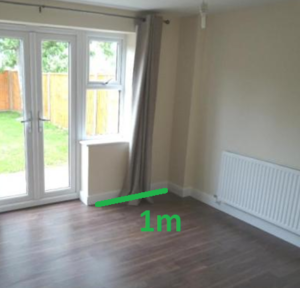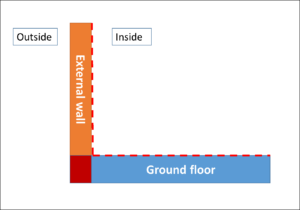Psi-values are a critical component within the design of low energy buildings.
Historically they have been given a cursory glance by design teams, and often left in the land of default values and ‘assumed performance’. However times are changing and an understanding of Psi values is critical when putting together an efficient building design.
What are Psi-Values?
 First of all, have you ever come across a u-value? This is a measure of the heat loss through a square meter of thermal element (e.g a wall).
First of all, have you ever come across a u-value? This is a measure of the heat loss through a square meter of thermal element (e.g a wall).
Well, Psi-values are a measure of heat loss along a meter of junction between two thermal elements, for example the line between a ground floor and an external wall (see green line in adjacent picture), and is measured in W/mK. These junctions are known collectively as thermal bridging.
Why do Psi-values matter?
U-values account for the heat loss through thermal elements but not the total heat loss through the fabric. At the junctions, there is additional heat loss referred to as non-repeating thermal bridges.
This is down to the geometry of the junction and also, in many cases, the construction of the junction:
- The geometry because, in SAP, we measure internal dimensions (see dotted red line below) and attribute U-values to thermal elements (e.g. external wall and ground floor) measured this way. We therefore underestimate the total heat loss. If we measured external dimensions, we would overestimate total heat loss (assuming no construction psi-value)
- The construction because materials used at the junction often have a higher thermal conductivity than those used in the thermal elements (e.g. a block of concrete at the junction rather than continuous insulation around the junction).
Build Energy can calculate bespoke Psi-values for your project – see Thermal Bridge Calculations

What to do about Psi Values?
In SAP Assessments, to best model the energy performance of a dwelling, we factor in Psi-values for all junctions as well as U-values for all exposed elements. To meet the latest building regs, Psi values need to be kept to a minimum.
In fact, for a realistic shot of achieving compliance, designers have needed to follow established schemes like Accredited Construction Details and Enhanced Construction Details.
These provide predetermined junction designs depending on the construction type, i.e a set for timber, and set for masonry and a set for steel. However these schemes are now outdated and their use will be restricted in the next release of SAP and Part L regs.
This means that designers are likely to either use certified make ups (with associated, predetermined Psi values attached) from manufacturers, or have their own calculated.
Some timber frame and SIPS manufacturers provide their own super low Psi values, which can be used by your assessor. On some very low energy builds, for example Passivhaus projects, clients will need to design out heat loss at junctions with bespoke Psi value calculations.
There also exist a few schemes set up by the insulation manufacturers, which allow you to demonstrate improved performance by using a combination of their products.
For more reading see:
Do you need help with a project?
Call us for a chat on 0330 055 34 05 or email be@buildenergy.co.uk.
